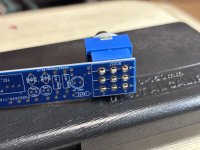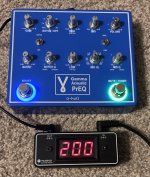You are using an out of date browser. It may not display this or other websites correctly.
You should upgrade or use an alternative browser.
You should upgrade or use an alternative browser.
Acoustic Preamp Design - Preamp & EQ
- Thread starter Rpschultz13
- Start date
Rpschultz13
Well-known member
Spent an hour playing it. First impressions, it has a TON of gain between gain (first) and volume (last), not to mention boost. Anyway loads of headroom. Drives me crazy when I’m plugged into a system and the sound guy wants more gain than I have.
Sounds real clean with the TLO74s. I’ve got some OPA4134s I want to try and measure if there’s any noise difference.
Sounds real clean with the TLO74s. I’ve got some OPA4134s I want to try and measure if there’s any noise difference.
Rpschultz13
Well-known member
I was checking the current because I'm using a Traco TEC 3-0923 DC-DC converter that takes 9vdc to 2 legs of +/-15vdc. It's rated for 100 mA per leg and 3W total. It's applying +/-15 v to the 4 op amps, or 30v across each. I have 1R resistors inline to measure the voltage and calculate the current (easy math and low voltage drop).
Above, I measure total current draw to be 200 mA at 9.44v using a current meter. I measure 0.195v across the 1R. So that makes sense. On each leg, I measure 0.038v across a 1R, or 38 mA, I can't use a current meter here so that's why I have 1R's.
200 mA at 9.44v is 1.9W, or 0.95W per side.
Divided by 30v is 32 mA per side. I measure 0.038v across the 1R on each leg, or 38 mA. So again, that math checks. The 1R's probably aren't exactly 1.0 Ω.
38 mA/side seems like I have roughly a safety factor of 3 on it's 100 mA/side capacity. But the 1.9W on the input looks like only about 50% headroom compared to the 3W rating. I was wondering if I need the 100mA/leg version, or if I could use the 2W - 67mA version, the Trace Tec 2-0923. It's $10 each instead of $15. If I look at current/leg, I have lots of room, but if I look at the Watt rating, I should stick with the 3W version.
CORRECTION:
The wattage rating is on the output.
So for the 2W version. 38mA @ 30v is 1.14W
38 mA is 57% of the rated 67 mA/side Also 1.14W about 57% of 2W.
I think the 2W version will work, and someone on AAC said the 2W version may be quieter than the 3W version.
Above, I measure total current draw to be 200 mA at 9.44v using a current meter. I measure 0.195v across the 1R. So that makes sense. On each leg, I measure 0.038v across a 1R, or 38 mA, I can't use a current meter here so that's why I have 1R's.
200 mA at 9.44v is 1.9W, or 0.95W per side.
Divided by 30v is 32 mA per side. I measure 0.038v across the 1R on each leg, or 38 mA. So again, that math checks. The 1R's probably aren't exactly 1.0 Ω.
38 mA/side seems like I have roughly a safety factor of 3 on it's 100 mA/side capacity. But the 1.9W on the input looks like only about 50% headroom compared to the 3W rating. I was wondering if I need the 100mA/leg version, or if I could use the 2W - 67mA version, the Trace Tec 2-0923. It's $10 each instead of $15. If I look at current/leg, I have lots of room, but if I look at the Watt rating, I should stick with the 3W version.
CORRECTION:
The wattage rating is on the output.
So for the 2W version. 38mA @ 30v is 1.14W
38 mA is 57% of the rated 67 mA/side Also 1.14W about 57% of 2W.
I think the 2W version will work, and someone on AAC said the 2W version may be quieter than the 3W version.
Last edited:
Rpschultz13
Well-known member
The biggest problem with pcb v3, is the 3PDT footprints, I had to modify the 3PDT's for them to fit. In hindsight, I could have simply drilled out the holes to 2.5mm, like this, now they fit.

If anyone wants to built this, it all seems to work and with this modification shouldn't be any trouble.
I'll eventually print pcb v4 when I'm done playing/testing v3. Besides the 3PDT footprint, the inductors are mislabeled 100 uH instead of 10 uH (or even 4.7uH is better). I also am switching the position of the mid gain and frequency knobs for v4 so the double pot (frequency) hangs off the top edge of the board like the notch/HPF frequency pot. And I want to make all the polarized caps the same direction to avoid confusion. That's it, minor stuff.
Nevertheless, v3 works great. I have 3 sets left of v3. If you want one, and you actually WILL build it, I'll send you a set if you pay for shipping ( probably $10 conus). I have Tayda drill/UV templates and a BOM I can send you. It's probably $90 in parts, the most expensive being the Traco DC DC converter ($15) and the 1590XX enclosure from Tayda ($13 bare or $26 drilled/UV). 3 of the pots are center detent (though not necessary) I get from StompBoxParts. There are 3 inductors that you may not have, but cheap from Mouser when you buy the Traco. Some of the film caps might be odd values, but again, mouser. It uses 3 TL074's and 1 NE5532, though I currently have OPA4134's in for the TL074's. An LM4562 is a high performance alternative to the NE5532 (for about $9).
PM me if interested.

If anyone wants to built this, it all seems to work and with this modification shouldn't be any trouble.
I'll eventually print pcb v4 when I'm done playing/testing v3. Besides the 3PDT footprint, the inductors are mislabeled 100 uH instead of 10 uH (or even 4.7uH is better). I also am switching the position of the mid gain and frequency knobs for v4 so the double pot (frequency) hangs off the top edge of the board like the notch/HPF frequency pot. And I want to make all the polarized caps the same direction to avoid confusion. That's it, minor stuff.
Nevertheless, v3 works great. I have 3 sets left of v3. If you want one, and you actually WILL build it, I'll send you a set if you pay for shipping ( probably $10 conus). I have Tayda drill/UV templates and a BOM I can send you. It's probably $90 in parts, the most expensive being the Traco DC DC converter ($15) and the 1590XX enclosure from Tayda ($13 bare or $26 drilled/UV). 3 of the pots are center detent (though not necessary) I get from StompBoxParts. There are 3 inductors that you may not have, but cheap from Mouser when you buy the Traco. Some of the film caps might be odd values, but again, mouser. It uses 3 TL074's and 1 NE5532, though I currently have OPA4134's in for the TL074's. An LM4562 is a high performance alternative to the NE5532 (for about $9).
PM me if interested.
Curious about this. I'm currently working on a preamp design and will be using a Traco Tec series converter because I've had good experience with them in a couple of Aion FX PCBs. I would have just copied the Aion FX pi filter on the input, which uses a 100uF, 10uH and 47uF. Always open to suggestions for improvements though.the inductors are mislabeled 100 uH instead of 10 uH (or even 4.7uH is better).
Rpschultz13
Well-known member
Yeah I did the same thing, copied L5 preamp. Take a look at the Traco tech notes, they aren’t exactly like the Aion schematic, they only suggest 1 inductor on the input, not both output legs.
The question is whether it could hurt to put those LC filters there. Wish those tech notes weren't as bare bones and had some real life measurements. I came across some notes by Texas Instruments on filtering DC-DC converters today but haven't had a chance to check it out yet.Yeah I did the same thing, copied L5 preamp. Take a look at the Traco tech notes, they aren’t exactly like the Aion schematic, they only suggest 1 inductor on the input, not both output legs.
Rpschultz13
Well-known member
Well, Aion does it, and my prototype does it. Seems fine. Maybe it’s not necessary.


